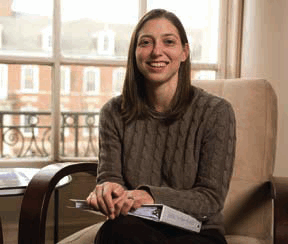 The same methods that engineers use to design better bridges or more efficient airplane wings are now being brought to bear on much smaller structures—the tiny structural elements inside our own cells.
The same methods that engineers use to design better bridges or more efficient airplane wings are now being brought to bear on much smaller structures—the tiny structural elements inside our own cells.
Lindsey Smith is a PhD candidate in the Department of Civil Engineering studying structural topology optimization, a method of designing structures from the ground up for maximum efficiency. Her goal: to use such techniques to gain insight into cellular structures like cytoskeletons and actin filaments. Her work could eventually result in advances such as better implantable medical devices, or artificial organs that mimic the structure and function of real organs.
The marriage of civil engineering and nanobiotechnology is an unusual one, admits Smith, who is working as part of a multidisciplinary team at the Institute for NanoBioTechnology, and is funded by a National Science Foundation Integrative Graduate Education and Research Traineeship grant. But as nanobiotechnology advances, she says, it makes sense to bring insights from civil engineering into the design of medical devices.
Normally, a scientist using structural topology optimization would start with a set of parameters, and then figure out how to create a design that optimized a particular property. For instance, a researcher might aim to design an airplane wing that is as light as possible while remaining strong enough to fly.
But in her work, Smith is approaching the problem from the other way around. She wants to analyze how evolution has designed the structural elements in the cell. “Evolution has optimized the cell,” she says. “It’s optimized for something, with a property or multiple properties in mind. Maybe in evolution, the most important thing is for the cytoskeleton to be rigid and also permeable. That should come through in the algorithms,” she explains.
Smith has an undergraduate degree in engineering mechanics from Columbia University. Her advisers are civil engineering Assistant Professor Jamie Guest and Professor Denis Wirtz of the Department of Chemical and Biomolecular Engineering. But she will eventually need a co-adviser in biology, materials science, or chemistry.
At the moment she is taking her core classes in civil and mechanical engineering, as well as cell biology courses, bringing herself up to speed on the inner workings of the cell. Soon she’ll begin working with mathematical models of the cell structures she’s interested in, as she formulates a thesis topic.




